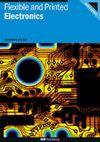Towards sustainable transparent flexible heaters: Integration of a BNNT interlayer using green solvent substitution
IF 3.2
4区 工程技术
Q3 MATERIALS SCIENCE, MULTIDISCIPLINARY
引用次数: 0
Abstract
Processing materials in electronics with non-toxic, green solvents can provide environmental benefits while reducing manufacturing health and safety challenges. Unfortunately, green solvents are often unable to provide comparable solubilizing characteristics and present challenges in printing and film formation compared to conventional organic solvents. Therefore, green materials are often developed in parallel to their processing method for successful implementation. In this study, we report on the use of a polyvinyl butyral (PVB) and ethanol solution as a replacement for poly (3-hexylthiophene-2,5-diyl) (P3HT) and chloroform and its’ first demonstration in boron nitride nanotube (BNNT) thin film interlayers for improved thermal and mechanical performance in silver microgrid transparent heaters. Using PVB/ethanol led to comparable thin films of BNNT, achieving a clear tube network formation across the substrate surface and resulting in near identical optical transparency and surface energy measurements compared to the P3HT/chloroform system. Silver microgrids printed on BNNT-coated polyethylene terephthalate (PET) with PVB as dispersant exhibited a similar conductive performance to the microgrids printed on BNNT-coated PET with P3HT, providing the same level of mechanical endurance and maintaining thermal performance metrics upon applied voltage. The PVB and ethanol system presents an exemplary green material combination for the novel deposition of BNNT thin film interlayers for integration into transparent heaters.迈向可持续透明柔性加热器:使用绿色溶剂替代的BNNT中间层集成
使用无毒、绿色溶剂加工电子材料可以带来环境效益,同时减少制造业的健康和安全挑战。不幸的是,与传统有机溶剂相比,绿色溶剂通常不能提供可比的增溶特性,并且在印刷和成膜方面存在挑战。因此,绿色材料的开发往往与其加工方法并行,才能成功实施。在本研究中,我们报道了使用聚乙烯醇缩丁醛(PVB)和乙醇溶液代替聚(3-己基噻吩-2,5-二基)(P3HT)和氯仿,并首次在氮化硼纳米管(BNNT)薄膜夹层中进行了演示,以改善银微网透明加热器的热性能和机械性能。与P3HT/氯仿系统相比,使用PVB/乙醇产生了可比的BNNT薄膜,在基板表面形成了清晰的管网,并产生了几乎相同的光学透明度和表面能测量值。用PVB作为分散剂印刷在涂有BNNT的聚对苯二甲酸乙二醇酯(PET)上的银微电网表现出与用P3HT印刷在涂了BNNT的PET上的微电网相似的导电性能,提供了相同水平的机械耐久性,并在施加电压时保持了热性能指标。PVB和乙醇系统提供了一种用于新型沉积BNNT薄膜夹层的示例性绿色材料组合,用于集成到透明加热器中。
本文章由计算机程序翻译,如有差异,请以英文原文为准。
求助全文
约1分钟内获得全文
求助全文
来源期刊

Flexible and Printed Electronics
MATERIALS SCIENCE, MULTIDISCIPLINARY-
CiteScore
4.80
自引率
9.70%
发文量
101
期刊介绍:
Flexible and Printed Electronics is a multidisciplinary journal publishing cutting edge research articles on electronics that can be either flexible, plastic, stretchable, conformable or printed. Research related to electronic materials, manufacturing techniques, components or systems which meets any one (or more) of the above criteria is suitable for publication in the journal. Subjects included in the journal range from flexible materials and printing techniques, design or modelling of electrical systems and components, advanced fabrication methods and bioelectronics, to the properties of devices and end user applications.
 求助内容:
求助内容: 应助结果提醒方式:
应助结果提醒方式:


